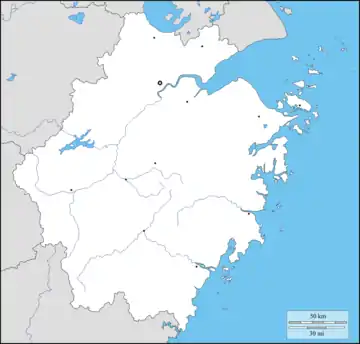Longgang, Zhejiang
Longgang is a county-level city of Zhejiang, China, under the administration of Wenzhou, located around 70 kilometres (43 mi) south of downtown Wenzhou.[1] The City lies on the south of the estuary of the Aojiang River, facing the Town of Aojiang, Pingyang County, across the river.[2] In 2018, it directly administrates an area of 183.99 square kilometres (71.04 sq mi) with 14 neighborhoods, 171 villages and 22 residential areas, and has a population of 378 thousands .[3]
Longgang
龙港市 | |
|---|---|
 Longxiang Road | |
 Longgang Location in Zhejiang | |
| Coordinates: 27°34′55″N 120°32′56″E | |
| Country | People's Republic of China |
| Province | Zhejiang |
| Prefecture-level city | Wenzhou |
| Incorporated town | October 19, 1983 (approved) |
| Incorporated city | August 27, 2019 (approved) |
| Area | |
| • Total | 183.99 km2 (71.04 sq mi) |
| Population (2018) | |
| • Total | 382,000 |
| • Density | 2,100/km2 (5,400/sq mi) |
| Time zone | UTC+8 (China Standard) |
The City was formed on the basis of five fishing villages and less than in 1983, following the seaport construction in 1982. In 1984, the No.1 Document of the State Council of China states that "farmers who can live self-sufficiently can be given hukou of city and town dwellers." Accordingly, the Town of Longgang decided to open up its hukou to such farmers who bought land to construct houses, or who did business in the Town.[4] In the first month, more than 3,000 registered for moving to the Town. Since then, the population of the Town started booming and in 1989, the Town's population reached 40,000. With the population increase, Longgang's economy boomed , and has become a center of printing industry in China. China Business Network has described Longgang as "probably the largest town in China".[5]
Ever since 1987, Longgang has begun appealing for cityhood. The related reforms have begun since 1996. In August 2019, approved by the Ministry of Civil Affairs, Longgang was proclaimed to be a county-level city by the provincial government of Zhejiang, which was the first among the economically developed towns in China.
Toponymy
The winding Aojiang River was also called the Qinglong River (青龙江; 青龍江; 'Green Loong River') by the locals of the south bank of the river, for the river resembles a green Chinese dragon (loong) in its lower reach.[6] After the establishment of Cangnan County in 1981, the County Government decided to built a sea port on the south bank. The villages of Longjiang (龙江; 龍江; 'Dragon River') and Yanjiang (沿江; 'Upon the River') was chosen as the site of the port.[7] After the site choice was announced in February 1982, the people of Lingxi, the county seat, began protesting against the decision in fear of the relocation of the county seat and beat the CCP high officials from Wenzhou.[8] Thus, the town near the port was not given a name due to political sensitiveness. The area was first called Yanjiang Port Area (沿江港区).[7] Since in Chinese, Yanjiang Port Area can be also interpreted as a port upon the river, which leads to ambiguity, the area was renamed as Longjiang Port Area (龙江港区; 龍江港區).[9] In 1983, when the Port Area appealed for township, Chen Junqiu, the official in command of the port, took one character from Longjiang (龙江; 龍江; 'Dragon River') and another from Port Area (港区; 港區) and made the blend word of Longgang (龙港; 龍港) to refer to the area.[7]
References
- 叶双莲; 王建平 (2015-01-07). "龙港,小城故事多". 温州网. Retrieved 2019-09-04.
- 陈绍雄; 徐启豆 (2012). "苍南龙港". In 中共浙江省委党史研究室; 当代浙江研究所 (eds.). 当代浙江城市发展 下. 北京: 当代中国出版社. ISBN 978-7-5154-0163-8.
- "浙江"巨无霸"乡镇龙港拟改市:推行由市直管村居". 2019-05-17. Archived from the original on 2019-08-30. Retrieved 2019-08-30.
- ""农民第一城"温州龙港撤镇设市". 观察者网. 2019-08-30. Archived from the original on 2019-08-30. Retrieved 2019-08-30.
- "可能是中国最大的镇!温州龙港升级,不再羡慕"城会玩"". 第一财经. 2016-07-31. Archived from the original on 2019-08-30. Retrieved 2019-08-30.
- 文沐 (1986). "苍南若干地名来历". In 中国人民政治协商会议浙江省苍南县委员会文史资料研究委员会 (ed.). 苍南文史资料 第2辑.
- 陈君球(回忆); 王艳琼(编辑) (2019-04-15). "龙港镇诞生前的那些艰难岁月——记龙江港区建设者们的创业故事". 浙江新闻. Archived from the original on 2019-08-30. Retrieved 2019-08-30.CS1 maint: multiple names: authors list (link)
- 孔南平 (2014-11-03). "镇改市落子:"第一座农民造城"龙港镇30年改革". 21世纪经济报道. Retrieved 2019-09-01 – via 搜狐新闻.
- Li, Hu & Yuan 2014, pp. 8–9
Cited books
- Li, Jinshan; Hu, Fengqiao; Yuan, Bo, eds. (2014). 三十岁的城市 龙港的孕育、诞生与发展 [30-year-old city: Longgang's conception, birth and development]. Hangzhou: Zhejiang University Press. ISBN 978-7-308-13909-0.
- Editorial Board of History of Longgang, ed. (2003). 龙港镇志(1991-2000) [History of Longgang Town (1991-2000)]. Beijing: Zhonghua Book Company. ISBN 7-101-03934-0. Archived from the original on 2019-04-20. Retrieved 2019-09-02.
Further reading
- Chen, Guanbo (1987). "中国的第一座农民城" [China's first farmers' city]. Wenhui Monthly (1): 140–148.
